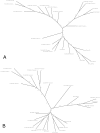Genome at juncture of early human migration: a systematic analysis of two whole genomes and thirteen exomes from Kuwaiti population subgroup of inferred Saudi Arabian tribe ancestry
- PMID: 24896259
- PMCID: PMC4045902
- DOI: 10.1371/journal.pone.0099069
Genome at juncture of early human migration: a systematic analysis of two whole genomes and thirteen exomes from Kuwaiti population subgroup of inferred Saudi Arabian tribe ancestry
Erratum in
- PLoS One. 2014;9(7):e103691
Abstract
Population of the State of Kuwait is composed of three genetic subgroups of inferred Persian, Saudi Arabian tribe and Bedouin ancestry. The Saudi Arabian tribe subgroup traces its origin to the Najd region of Saudi Arabia. By sequencing two whole genomes and thirteen exomes from this subgroup at high coverage (>40X), we identify 4,950,724 Single Nucleotide Polymorphisms (SNPs), 515,802 indels and 39,762 structural variations. Of the identified variants, 10,098 (8.3%) exomic SNPs, 139,923 (2.9%) non-exomic SNPs, 5,256 (54.3%) exomic indels, and 374,959 (74.08%) non-exomic indels are 'novel'. Up to 8,070 (79.9%) of the reported novel biallelic exomic SNPs are seen in low frequency (minor allele frequency <5%). We observe 5,462 known and 1,004 novel potentially deleterious nonsynonymous SNPs. Allele frequencies of common SNPs from the 15 exomes is significantly correlated with those from genotype data of a larger cohort of 48 individuals (Pearson correlation coefficient, 0.91; p <2.2×10-16). A set of 2,485 SNPs show significantly different allele frequencies when compared to populations from other continents. Two notable variants having risk alleles in high frequencies in this subgroup are: a nonsynonymous deleterious SNP (rs2108622 [19:g.15990431C>T] from CYP4F2 gene [MIM:*604426]) associated with warfarin dosage levels [MIM:#122700] required to elicit normal anticoagulant response; and a 3' UTR SNP (rs6151429 [22:g.51063477T>C]) from ARSA gene [MIM:*607574]) associated with Metachromatic Leukodystrophy [MIM:#250100]. Hemoglobin Riyadh variant (identified for the first time in a Saudi Arabian woman) is observed in the exome data. The mitochondrial haplogroup profiles of the 15 individuals are consistent with the haplogroup diversity seen in Saudi Arabian natives, who are believed to have received substantial gene flow from Africa and eastern provenance. We present the first genome resource imperative for designing future genetic studies in Saudi Arabian tribe subgroup. The full-length genome sequences and the identified variants are available at ftp://dgr.dasmaninstitute.org and http://dgr.dasmaninstitute.org/DGR/gb.html.
Conflict of interest statement
Figures







Similar articles
-
Kuwaiti population subgroup of nomadic Bedouin ancestry-Whole genome sequence and analysis.Genom Data. 2014 Dec 18;3:116-27. doi: 10.1016/j.gdata.2014.11.016. eCollection 2015 Mar. Genom Data. 2014. PMID: 26484159 Free PMC article.
-
Sequence and analysis of a whole genome from Kuwaiti population subgroup of Persian ancestry.BMC Genomics. 2015 Feb 18;16(1):92. doi: 10.1186/s12864-015-1233-x. BMC Genomics. 2015. PMID: 25765185 Free PMC article.
-
The genetic structure of the Kuwaiti population: mtDNA Inter- and intra-population variation.Hum Biol. 2012 Aug;84(4):379-403. doi: 10.3378/027.084.0403. Hum Biol. 2012. PMID: 23249314
-
Generalizability of GWA-Identified Genetic Risk Variants for Metabolic Traits to Populations from the Arabian Peninsula.Genes (Basel). 2021 Oct 18;12(10):1637. doi: 10.3390/genes12101637. Genes (Basel). 2021. PMID: 34681031 Free PMC article. Review.
-
Genetic intolerance analysis as a tool for protein science.Biochim Biophys Acta Biomembr. 2020 Jan 1;1862(1):183058. doi: 10.1016/j.bbamem.2019.183058. Epub 2019 Sep 5. Biochim Biophys Acta Biomembr. 2020. PMID: 31494120 Free PMC article. Review.
Cited by
-
Genetic Diversity and Low Stratification of the Population of the United Arab Emirates.Front Genet. 2020 Jun 12;11:608. doi: 10.3389/fgene.2020.00608. eCollection 2020. Front Genet. 2020. PMID: 32595703 Free PMC article.
-
Introducing the first whole genomes of nationals from the United Arab Emirates.Sci Rep. 2019 Oct 11;9(1):14725. doi: 10.1038/s41598-019-50876-9. Sci Rep. 2019. PMID: 31604968 Free PMC article.
-
Systematics for types and effects of DNA variations.BMC Genomics. 2018 Dec 28;19(1):974. doi: 10.1186/s12864-018-5262-0. BMC Genomics. 2018. PMID: 30591019 Free PMC article. Review.
-
Kuwaiti population subgroup of nomadic Bedouin ancestry-Whole genome sequence and analysis.Genom Data. 2014 Dec 18;3:116-27. doi: 10.1016/j.gdata.2014.11.016. eCollection 2015 Mar. Genom Data. 2014. PMID: 26484159 Free PMC article.
-
Comprehensive and deep evaluation of structural variation detection pipelines with third-generation sequencing data.Genome Biol. 2024 Jul 15;25(1):188. doi: 10.1186/s13059-024-03324-5. Genome Biol. 2024. PMID: 39010145 Free PMC article.
References
-
- Altshuler D, Hirschhorn JN, Klannemark M, Lindgren CM, Vohl MC, et al. (2000) The common PPARgamma Pro12Ala polymorphism is associated with decreased risk of type 2 diabetes. Nat Genet 26: 76–80. - PubMed
-
- Zhu J, Cui L, Wang W, Hang XY, Xu AX, et al... (2013) Whole exome sequencing identifies mutation of EDNRA involved in ACTH-independent macronodular adrenal hyperplasia. Fam Cancer. - PubMed
-
- De La Vega F, Hyland F, McLaughlin S, Ni J, Fu Y, et al.. (2009) Functional analysis of the genetic variation within the genomes of three HapMap individuals obtained by whole-genome, second-generation sequencing. (Data downloaded from http://www.sequenceontology.org/resources/10Gen.html).
Publication types
MeSH terms
Substances
LinkOut - more resources
Full Text Sources
Other Literature Sources

